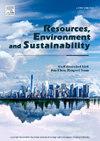中国不同饲料集约化养猪业碳氮足迹分析
IF 12.4
Q1 ENVIRONMENTAL SCIENCES
引用次数: 0
摘要
在养猪规模化生产的整个过程中,饲料生产在温室气体(GHG)排放和氮(N)排放方面造成了巨大的环境压力。此外,不同的饲料会产生不同的结果。而以往的研究很少分析饲料成分或饮食选择的碳足迹和氮足迹。因此,我们选择了中国这个世界上最大的猪肉生产国和消费国,通过不同饲料成分的猪生产生命周期来分析氮足迹和碳足迹。采用生命周期环境足迹和情景分析的方法,比较了中国规模化生猪生产中不同原料的碳足迹、氮足迹和饲料价格。生猪生产的生命周期包括饲料作物种植、饲料加工、生猪饲养和粪便管理。功能单位为1公斤生猪的体重。结果表明:不同饲养条件下,猪的碳足迹、氮足迹和饲料价格分别为1.67 ~ 1.70 kg CO2-eq FU−1、35.3 g Nr FU−1 ~ 38.9 g Nr FU−1和1.42 ~ 2.15 CNY kg−1。饲料作物生产和肥料管理分别贡献了最大的碳足迹(54%)和最大的氮足迹(64%)。这四种场景表现出不同的结果。方案3 (S3),用可溶酒糟干谷物(DDGS)代替原饲料中的豆粕,在碳和氮足迹以及饲料价格方面表现出更有利的结果。这主要归因于饲料作物种植、粪便管理、饲料粗蛋白质含量和饲料作物价格。针对中国饲料作物产量、生猪产仔数、饲料消费和省际运输的不均匀性,在最优S3下进行了空间分析。结果表明,由于北方地区种植作物饲料,中国北方省份的碳足迹和氮足迹均高于南方省份。最后,从养殖实践、饲料调整、粪便管理和战略区划等方面提出建议。该研究不仅强调了环境足迹对分析生猪生产环境影响的重要性,而且从饲料调整的角度为提高该行业的环境可持续性提供了启示。本文章由计算机程序翻译,如有差异,请以英文原文为准。

Insights into carbon and nitrogen footprints of large-scale intensive pig production with different feedstuffs in China
Through the whole process of large-scale pig production, feed production puts great environmental pressure in terms of greenhouse gas (GHG) emissions and nitrogen (N) emission. Additionally, different feedstuffs will have different results. While previous studies seldom analyzed carbon footprint and nitrogen footprint from feed components or diet choices. Thus, we selected China, the largest producer and consumer of pork in the world, to analyze both nitrogen footprint and carbon footprint through the life cycle of pig production with different feed components. We used life-cycle environmental footprint and scenario analysis to compare carbon footprints, nitrogen footprints, and feed prices of large-scale pig production with different feedstuffs in China. The life cycle of the pig production includes feed crop cultivation, feed processing, pig raising, and manure management. The functional unit is the weight of 1 kg of live pig. The results showed that the carbon footprints, nitrogen footprints, and feed prices ranged from 1.67 kg CO2-eq FU−1 to 1.70 kg CO2-eq FU−1, 35.3 g Nr FU−1 to 38.9 g Nr FU−1, and 1.42 CNY kg −1 to 2.15 CNY kg −1, respectively. Feed crop production and manure management contributed the largest carbon footprint (54%) and the largest nitrogen footprint (64%), respectively. The four scenarios exhibited various results. Scenario 3 (S3), substituting soybean meal in the original feed with distillers dried grains with soluble (DDGS), presented a more favorable outcome with respect to carbon and nitrogen footprints as well as feed prices. This was mainly attributed to feed crop cultivation, manure management, crude protein contents of feeds, and prices of the feed crops. Concerning the uneven feed crop production, number of pig farrowed, feed consumption, and inter-provincial transportation across China, we conducted the spatial analysis under the optimal S3. It revealed that the northern provinces in China exhibited both higher carbon and nitrogen footprints than the southern provinces, due to the northern regions cultivating the crop feed. Finally, we proposed recommendations from perspectives of cultivation practice, feed adjustment, manure management, and strategic zoning. The study not only highlighted the importance of environmental footprint for analyzing environmental impacts of pig production, but also provided the implications for enhancing the sector’s environmental sustainability from perspective of feed adjustment.
求助全文
通过发布文献求助,成功后即可免费获取论文全文。
去求助
来源期刊

Resources Environment and Sustainability
Environmental Science-Environmental Science (miscellaneous)
CiteScore
15.10
自引率
0.00%
发文量
41
审稿时长
33 days
 求助内容:
求助内容: 应助结果提醒方式:
应助结果提醒方式:


